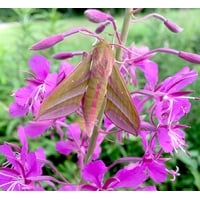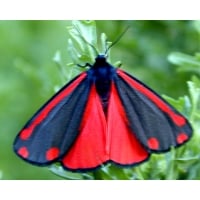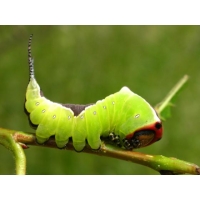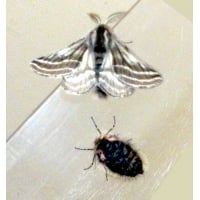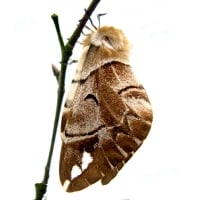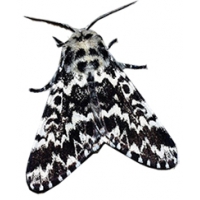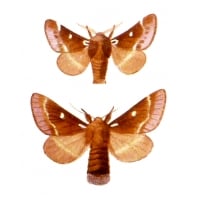WINTER PUPAE for breeding in the following season
Elephant Hawk Dielephila elpenor
Store winter pupae refrigerated in a plastic box. In the emerging cage it is important to have the pupae moist but well drained. Please see the Pupae Nest on this website. The moths usually emerge in June and July.
Cage the moths with nectar flowers and springs of Willowherb – you do not see the pairings but fertile eggs are easily obtained.
An exceptionally pretty moth with amazing and characterful larvae, with eye-spots and probing “trunks”. Young larvae are green, later changing to charcoal black, with occasional rarities remaining green.
Larvae feed on Willowherbs, Fuschia, Creepers.
Highly recommended.
Spurge Hawk Hyles euphorbiae
A very rare migrant to Britain. They have been found on sand dunes on the southern shores of England.
Fine, healthy pupae to emerge soon. In the emerging cage keep as described for the Pupae Nest on this website.
The moths breed at night and pairings are seldom seen. Provide potted foodplant on which the clusters of green eggs are laid. The larvae are black at first and they are gregarious. As they grow they separate and take on a multitude of amazingly bright and varied colours. The larvae will feed on most Spurges, including the summer weed Sun or Petty Spurge. The moths lay well on the tender shoots and Cypress Spurge Euphorbia cyparissias is a favourite. Larger larvae will feed the coarser Spurges, such as Caper Spurge and Wulfeni.
Pupae are formed on or beneath the surface of the ground. In warm conditions there may be multiple generations. Winter is spent as dormant pupae.
Only a few. They are for breeding in summer.
Dormant pupae are kept cool for the winter. Adults emerge in June/July.
Provide nectar flowers and potted Spurge plants for egg-laying. The best Spurges are Cypress Spurge (cyparissias), Wood Spurge, Sea Spurge, and the annual Sun or Petty Spurges are all suitable. Eggs are laid in clutches near the tips. The young larvae are black and cluster.
Soon they take on amazing spots and stripes of yellow, red, white and green. Some of the most colourful larvae in the world.
Cinnabar Moth Hipocrita jacobaeae pupae
Once an extremely common British Moth, less common over most of Europe, but over the last 10 years there has been a marked decline in numbers. The summer of 2016 brought a reversal of this decline and we have a fine stock of pupae available, as a result of breeding.
The larvae feed on Groundsel and Ragwort Senecio. The larvae are ringed in bright orange and black, nature's warning colours, and they absorb chemicals from the foodplant that adversely affect predators who ignore the warning. Ragwort is a mis-understood plant that provides an abundance of nectar to bees, butterflies and other insects. There is evidence that Ragwort plants that are pulled up and left to dry, can be detrimental to cattle and horses if they eat the dried plants. Animals can be seen grazing safely in fields containing growing green plants. There is nothing to be gained from pulling up Ragwort plants, because they are biennials that flower and die in the same year. So a patch of Ragwort can provide valuable nectar to thousands of wild insects, and be host to Cinnabar larvae and, job completed, it dies at the end of summer.
The Cinnabar moth flies by day, more than by night, and is protected from predators, by the very striking colours of charcoal and scarlet, and bitter-tasting chemicals derived from the larval foodplant, enabling the moth to display its bright colours, yet not be attacked by predators.
Cinnabar larvae can be raised in sleeves on growing Ragwort. We find the sleeves fitted with a zip are particularly successful. When the larvae are large, if you put in the sleeve several handfuls of springy wood shavings or dried leaf litter, they will form thin silken cocoons in which to pupate.
Could you help to spread this colourful day-flying moth again in your area?
Store pupae cool for the winter, even in a fridge, loose in a plastic box, without any padding. In May lay them out in an emerging cage and wait for the moths to emerge.
Cinnabar Moth Hipocrita jacobaeae pupae
Once an extremely common British Moth, less common over most of Europe, but over the last 10 years there has been a marked decline in numbers. The summer of 2016 brought a reversal of this decline and we have a fine stock of pupae available, as a result of breeding.
The larvae feed on Groundsel and Ragwort Senecio. The larvae are ringed in bright orange and black, nature's warning colours, and they absorb chemicals from the foodplant that adversely affect predators who ignore the warning. Ragwort is a mis-understood plant that provides an abundance of nectar to bees, butterflies and other insects. There is evidence that Ragwort plants that are pulled up and left to dry, can be detrimental to cattle and horses if they eat the dried plants. Animals can be seen grazing safely in fields containing growing green plants. There is nothing to be gained from pulling up Ragwort plants, because they are biennials that flower and die in the same year. So a patch of Ragwort can provide valuable nectar to thousands of wild insects, and be host to Cinnabar larvae and, job completed, it dies at the end of summer.
The Cinnabar moth flies by day, more than by night, and is protected from predators, by the very striking colours of charcoal and scarlet, and bitter-tasting chemicals derived from the larval foodplant, enabling the moth to display its bright colours, yet not be attacked by predators.
Cinnabar larvae can be raised in sleeves on growing Ragwort. We find the sleeves fitted with a zip are particularly successful. When the larvae are large, if you put in the sleeve several handfuls of springy wood shavings or dried leaf litter, they will form thin silken cocoons in which to pupate.
Could you help to spread this colourful day-flying moth again in your area?
Store pupae cool for the winter, even in a fridge, loose in a plastic box, without any padding. In May lay them out in an emerging cage and wait for the moths to emerge.
Puss Moth Dicranura vinula
Pupae are VERY seldom available, but there are some in stock NOW!
An absolute favourite of seasoned breeders, yet ideal for beginners. Cocoons are formed on bark and are harder than bark. Moths emerge from May. Pairings are easy, no foodplant or flowers necessary.
In captivity eggs are laid on the cage or box, in considerable numbers. The larvae are amazing, with twin tails which eject fine scarlet flagellae when the larva is disturbed. The large larva has a fearsome “face” and a characteristic saddle of purple, on bright green. This species is amongst the most curious larvae in the world.
Foodplants are Poplars, Willows and Sallows.
The Belted Beauty Lycia zonaria
In Britain this species is very rare indeed, and protected. Found in only about 3 localities on sandy nutrient-poor grassland or dunes. Very scarce in Holland, where it occurs in similar coastal areas. Our stock comes from central Europe, where it is sometimes found on dry limestone slopes where the vegetation is sparse.
Eggs are laid in batches particularly on grasses where they can be tucked into pockets and hollow stems. The larvae feed on a variety of vegetation - possibly almost anything that is growing amongst the grasses. They are recorded as feeding on Dandelion, Dock, Cow Parsley,Clovers, Kidney Vetch, Bird’s-foot Trefoil, Yarrow, Creeping Willows and Sallows, Hawthorn, Coltsfoot, Plantains, Burnet Rose and even Flag Iris. The larva, starting black with prominent white spots, becomes medium green, well camouflaged colour, but with a prominent lemon yellow lateral stripe. This is a Geometer - looper caterpillar. This is one of the few moths that has a wingless female. The female rests sometimes prominently where they more easily attract males, which fly by day and by night.
The pupa is formed only a little below the ground surface, where it spends the winter. Store winter pupae in a closed plastic box, very cool or refrigerated. To avoid desiccation don't leave in open air. In the emerging cage, keep moist at all times. See the Pupae Nest on this website. Emergence starts in the very early spring.
This is an opportunity not to be missed, to breed a very rare species and see its life history at first hand.
Kentish Glory Endromis versicolora
Store pupae refrigerated until February/March when the adults emerge and breed. Provide Birch twigs for females to lay their clusters of yellow eggs. In normal cold conditions, the eggs don't hatch before the foodplant buds open.
This species is now found only in Scotland, and parts of Central Europe. These are European stock. Emerging as early as February. The first eggs and larvae are ready in March. Clusters of bright yellow eggs are laid on bare Birch twigs. Just go out and cut some twigs and arrange them in the cage. The eggs gradually change to a deep purple colour which matches the colour of the twigs. In captivity, the eggs can hatch before the Birch buds are open, so keep some twigs warm inside, standing in water, to get them to sprout.
If you can sleeve the larvae on a growing plant, potted or in the ground, rearing is very easy. The larvae, black at first, cluster on the twigs. Later they are green and spread out a little, clinging on to the twigs, they look just like Birch catkins. Absolute masters of camouflage. In May the larvae pupate in leaf litter and settle down until the new season starts again in February. This is a very easy species: just make sure you have enough growing foodplant (it can be in pots). The male and female moths share the same patterning, but the female is much larger and the male has particularly rich chestnut markings. Pairing is easy. Just leave the moths together and Nature takes care of things.
Note Kentish Glory larvae can also be fed on Hazel, Alder, Hornbeam, and Lime. It is probable that other alternative tree species may be used as foodplant.
Our thanks to Jens Stolt who has kindly allowed us to use his beautiful illustration of the life history of this rare species.
Pine Arches Moth Panthea coenobita
Very seldom offered. A Noctuid that has characteristics akin to the Tussocks. The caterpillar is beautifully coloured and patterned with tufts and tussocks of hair, giving it excellent camouflage on the twigs of its foodplants which are Pines Pinus, Spruces Abies and Larches Larix.
Coenobita is relatively unknown and few breeders have raised it. The species is found over many parts of Europe (excluding Britain) Spain and most of France. Its range extends to the Far East.
Small Eggar Moth Eriogaster lanestris
The moths emerge in March/April. On receipt of the pupae they should be refrigerated until spring. The moths form inside the cocoon in late winter. The moment the temperature rises, they burst forth, and it is inadvisable to let them do this too early, or any fertile eggs might hatch before there is any foodplant.
Because of modern practice of hedge management, this once common species is nowadays a rare find. Tight clipping of hedges destroys the habitat and undoubtedly the eggs and larvae.
Egg clusters are laid in batches, covered with black fluff from the tip of the female's abdomen, on branches of the foodplant Blackthorn Prunus spinosa or Hawthorn Crataegus monogyna. The larvae cluster, and even large larvae live within, and on the outsite of a prominent white tent of silk, very often at the end of a branch, with no attempt at concealment. It is likely that the larvae in captivity could be reared on Apple and Plum, though we have not tried these.
Don't be tempted to handle the larvae. They have short, decorative hairs, which easily come away and if they penetrate the skin, like short cactus prickles, this can give rise to intense irritation. No doubt this is why the larvae can afford to display themselves in the wild so openly. No predator will try to eat them once they learn, and the larvae are patterned in warning colours to advertise the danger.
To pupate, the larvae descend to form a tight cocoon with a smooth shell-like a nut, in concealed leaf litter or moss, where they spend the winter. In early spring, the moths are fully formed within the pupal shell, ready to emerge the moment they sense that conditions are right. If you take the nut-like cocoons from the cold and put them into room temperature, the moths will suddenly break open the ends of the cocoons and there will be a whole lot of moths in a very short time!
You might help to spread the species locally if you can find thorn hedges that are not regularly trimmed. Cocoons are immediately available. Keep them in the fridge until April. You will enjoy observing this species, in all its interesting stages, and maybe could introduce it to your area.
Tau Emperor Aglia tau
This European Silkmoth emerges about the same time as the Emperor Moth, in early spring, and is in the same family of Silkmoths (Saturniidae). Very easy to breed: lay the pupae out in February for March/April emergence. The moths fly and pair by day, and particularly appreciate sunshine. Eggs are laid on the cage sides.
The young larvae are adorned with antlers, as impressive as the American Hicory Horned Devils! Foodplants include Lime, Oak, Birch, Hawthorn, and other trees and shrubs. Pupation is in leaf litter. Single brooded.
Highly recommended.
Tau Emperor Aglia tau
This European Silkmoth emerges about the same time as the Emperor Moth, in early spring, and is in the same family of Silkmoths (Saturniidae). Very easy to breed: lay the pupae out in February for March/April emergence. The moths fly and pair by day, and particularly appreciate sunshine. Eggs are laid on the cage sides.
The young larvae are adorned with antlers, as impressive as the American Hicory Horned Devils! Foodplants include Lime, Oak, Birch, Hawthorn, and other trees and shrubs. Pupation is in leaf litter. Single brooded.
Highly recommended.
Emperor Moth Saturnia pavonia
Britain’s only Silkmoth. The male and female have similar markings, but the female is larger, and the male is more brightly coloured.
Emergence is in March/April. Pairing is easy – if you have a female, she may attract males from miles away. The Emperor Moth occurs in many rural areas but is particularly found on heaths, where they breed on Heathers. The larvae feed on a variety of plants, including Bramble, Raspberry, Hawthorn, Blackthorn, Apple, Plum, Blackthorn, Oak, Hornbeam, Birch, Heathers and Heaths, Blueberry, Meadowsweet, Wild Rose, Sea Buckthorn, Purple Loosestrife, Willows especially Osier Salix viminalis, Pussy Willow (Sallow).
The caterpillars cluster in the early instars, eventually spreading out and becoming brightly coloured, as beautiful as such exotics as the Moon Moths. The cocoon is spun in the foodplant. An interesting construction with a neck and open end, through which the adult emerges.
Store cocoons in a plastic box in a fridge until March. The moths normally emerge in April.
This is one of the fun species to rear. Demand for this species is high. Please order early.

